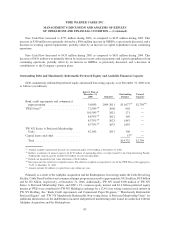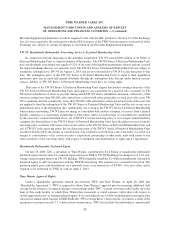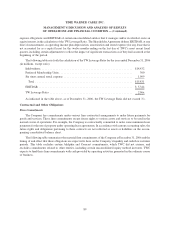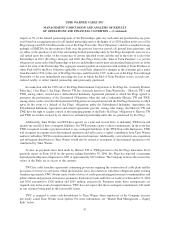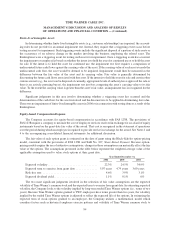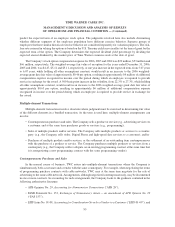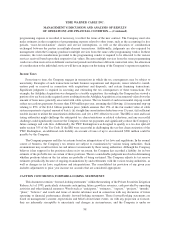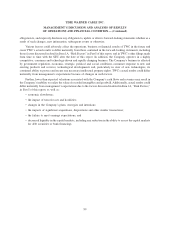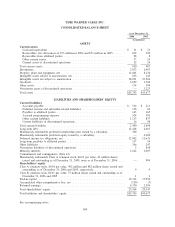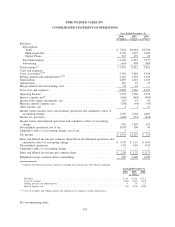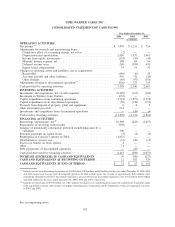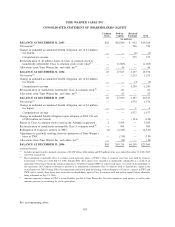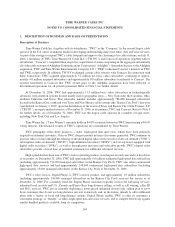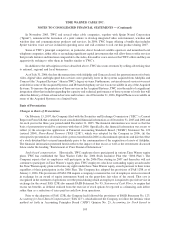Time Warner Cable 2006 Annual Report Download - page 100
Download and view the complete annual report
Please find page 100 of the 2006 Time Warner Cable annual report below. You can navigate through the pages in the report by either clicking on the pages listed below, or by using the keyword search tool below to find specific information within the annual report.predict the expected term of an employee stock option. The judgments involved here also include determining
whether different segments of the employee population have different exercise behavior. Separate groups of
employees that have similar historical exercise behavior are considered separately for valuation purposes. The risk-
free rate assumed in valuing the options is based on the U.S. Treasury yield curve in effect at the time of grant for the
expected term of the option. The Company determines the expected dividend yield percentage by dividing the
expected annual dividend by the market price of Time Warner common stock at the date of grant.
The Company’s stock option compensation expense for 2006, 2005 and 2004 was $29 million, $53 million and
$66 million, respectively. The weighted-average fair value of an option for the years ended December 31, 2006,
2005 and 2004, was $4.47, $5.11 and $5.11, respectively. A one year increase in the expected term, from 5.07 years
to 6.07 years, while holding all other assumptions constant, would result in an increase to the 2006 weighted-
average grant date fair value of approximately $0.46 per option, resulting in approximately $4 million of additional
compensation expense recognized in income over the period during which an employee is required to provide
service in exchange for the award. A 500 basis point increase in the volatility, from 22.3% to 27.3%, while holding
all other assumptions constant, would result in an increase to the 2006 weighted-average grant date fair value of
approximately $0.63 per option, resulting in approximately $6 million of additional compensation expense
recognized in income over the period during which an employee is required to provide service in exchange for
the award.
Multiple-element Transactions
Multiple-element transactions involve situations where judgment must be exercised in determining fair value
of the different elements in a bundled transaction. As the term is used here, multiple-element arrangements can
involve:
• Contemporaneous purchases and sales. The Company sells a product or service (e.g., advertising services) to
a customer and at the same time purchases goods or services (e.g., programming);
• Sales of multiple products and/or services. The Company sells multiple products or services to a counter-
party (e.g., the Company sells video, Digital Phone and high-speed data services to a customer); and/or
• Purchases of multiple products and/or services, or the settlement of an outstanding item contemporaneous
with the purchase of a product or service. The Company purchases multiple products or services from a
counterparty (e.g., the Company settles a dispute on an existing programming contract at the same time that
it is renegotiating a new programming contract with the same programming vendor).
Contemporaneous Purchases and Sales
In the normal course of business, TWC enters into multiple-element transactions where the Company is
simultaneously both a customer and a vendor with the same counterparty. For example, when negotiating the terms
of programming purchase contracts with cable networks, TWC may at the same time negotiate for the sale of
advertising to the same cable network. Arrangements, although negotiated contemporaneously, may be documented
in one or more contracts. In accounting for such arrangements, the Company looks to the guidance contained in the
following authoritative literature:
• APB Opinion No. 29, Accounting for Nonmonetary Transactions (“APB 29”);
• FASB Statement No. 153, Exchanges of Nonmonetary Assets — an amendment of APB Opinion No. 29
(“FAS 153”);
• EITF Issue No. 01-09, Accounting for Consideration Given by a Vendor to a Customer (“EITF 01-09”); and
95
TIME WARNER CABLE INC.
MANAGEMENT’S DISCUSSION AND ANALYSIS OF RESULTS
OF OPERATIONS AND FINANCIAL CONDITION — (Continued)


